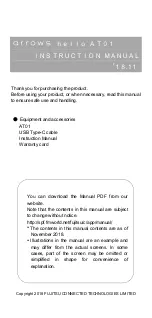
EM-55 OR Owner’s Manual
3
ENGLISH
ENGLISH
ENGLISH
ENGLISH
In addition to the items listed under “Important Safety Instructions”, please read and observe the following:
Power supply
• Do not use this instrument on the same power circuit with any
device that will generate line noise (such as an electric motor or
variable lighting system).
• Be sure to only use the supplied adapter (Roland ACJ). The use of
other adapters may damaged your EM-55 OR.
• Before connecting the EM-55 OR to other devices, turn off the
power to all units. This will help prevent malfunctions and/or dam-
age to speakers or other devices.
Placement
• Using the EM-55 OR near power amplifiers (or other equipment
containing large power transformers) may induce hum. To alleviate
the problem, change the orientation of this instrument or move it
farther away from the source of interference.
• This instrument may interfere with radio and television reception.
Do not use it in the vicinity of such receivers.
• Do not expose the EM-55 OR to direct sunlight, place it near
devices that radiate heat, leave it inside an enclosed vehicle, or
otherwise subject it to temperature extremes. Excessive heat can
deform or discolor the instrument.
Maintenance
• For everyday cleaning wipe the EM-55 OR with a soft, dry cloth or
one that has been slightly dampened with water. To remove stub-
born dirt, use a mild, non-abrasive detergent. Afterwards, be sure
to wipe the instrument thoroughly with a soft, dry cloth.
• Never use benzene, thinner, alcohol or solvents of any kind, to
avoid the possibility of discoloration and/or deformation.
Repairs and data
• Please be aware that all data contained in the instrument’s mem-
ory may be lost when it is sent for repairs. In certain cases (such as
when circuitry related to memory itself is out of order), we regret
that it may not be possible to restore the data. Roland assumes no
liability concerning such loss of data.
Additional precautions
• Please be aware that the memory contents can be irretrievably lost
as a result of a malfunction, or the improper operation of the
instrument.
• Use a reasonable amount of care when using the instrument’s but-
tons, other controls, and jacks/connectors. Rough handling can
lead to malfunctions.
• Never strike or apply strong pressure to the display.
• When connecting/disconnecting cables, grasp the connector
itself—never pull on the cable. This way you will avoid causing
shorts, or damage to the cable’s internal elements.
• A small amount of heat will radiate from the instrument during
normal operation. This is perfectly normal.
• To avoid disturbing your neighbors, try to keep the instrument’s
volume at reasonable levels. You may prefer to use headphones, so
you do not need to be concerned about those around you (espe-
cially late at night).
• When you need to transport the instrument, package it in the box
(including padding) that it came in. Otherwise, you will need to use
equivalent packaging materials, or a flightcase.
Handling floppy disks
• Floppy disks contain a plastic disk with a thin magnetic coating.
Microscopic precision is required to enable storage of large
amounts of data on such a small surface area. To preserve their
integrity, please observe the following when handling floppy disks:
• Never touch the magnetic medium inside the disk.
• Do not use or store floppy disks in dirty or dusty areas.
• Do not subject floppy disks to temperature extremes (e.g., direct
sunlight in an enclosed vehicle). Recommended temperature
range: 10° to 50°C (50 to 122°F).
• Do not expose floppy disks to strong magnetic fields, such as those
generated by loudspeakers.
• Floppy disks have a “WRITE” tab which can protect the disk from
accidental erasure. It is recommended that the tab be kept in the
PROTECT position, and moved to the WRITE position only when
you wish to write new data onto the disk.
• Disks containing important performance data for this instrument
should always be locked (have their write protect tab slid to the
PROTECT position) before you insert them into the drive of another
instrument.
• The identification label should be firmly affixed to the disk. If the
label comes loose while the disk is in the drive, it may be difficult
to remove the disk.
• Put the disk back into its case for storage.
1. Important notes
Rear side of the disk
PROTECT
(prevents writing to disk)
WRITE
(you can save new data to disk)
Write protect tab
EM-55OR_UK Page 3 Wednesday, July 10, 2002 3:32 PM
Summary of Contents for EM-55 OR
Page 98: ...Index 98 ...




































